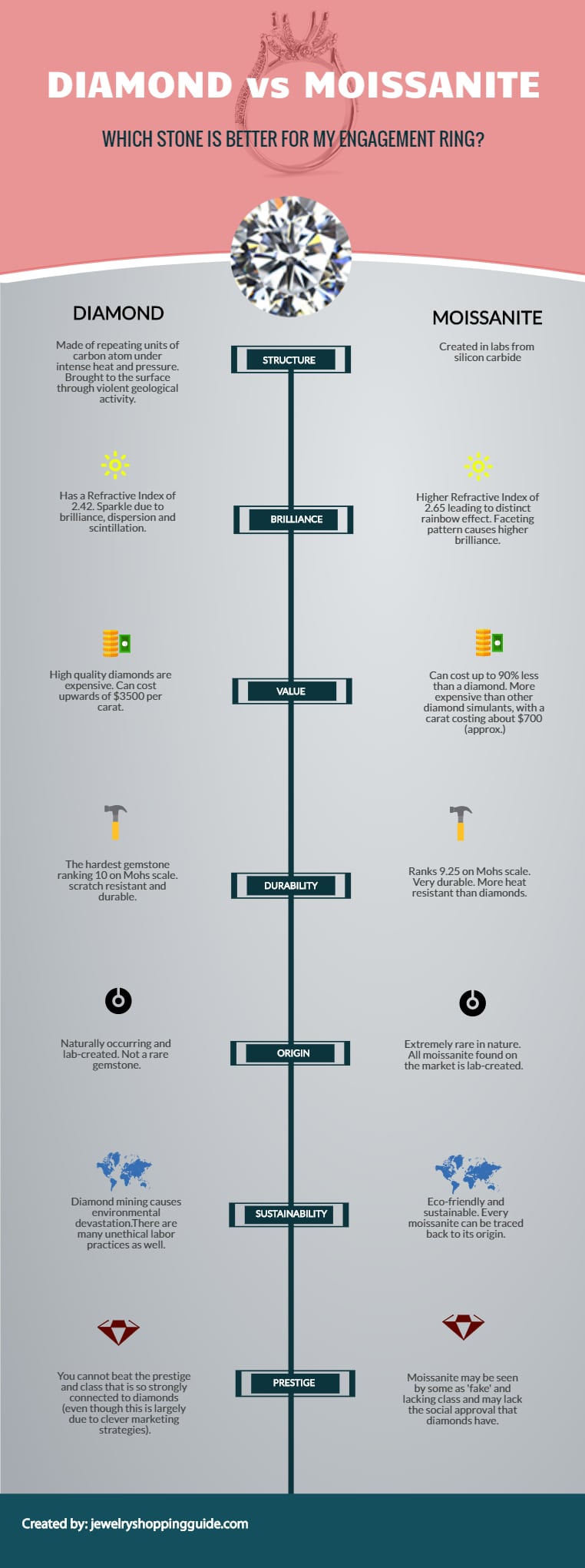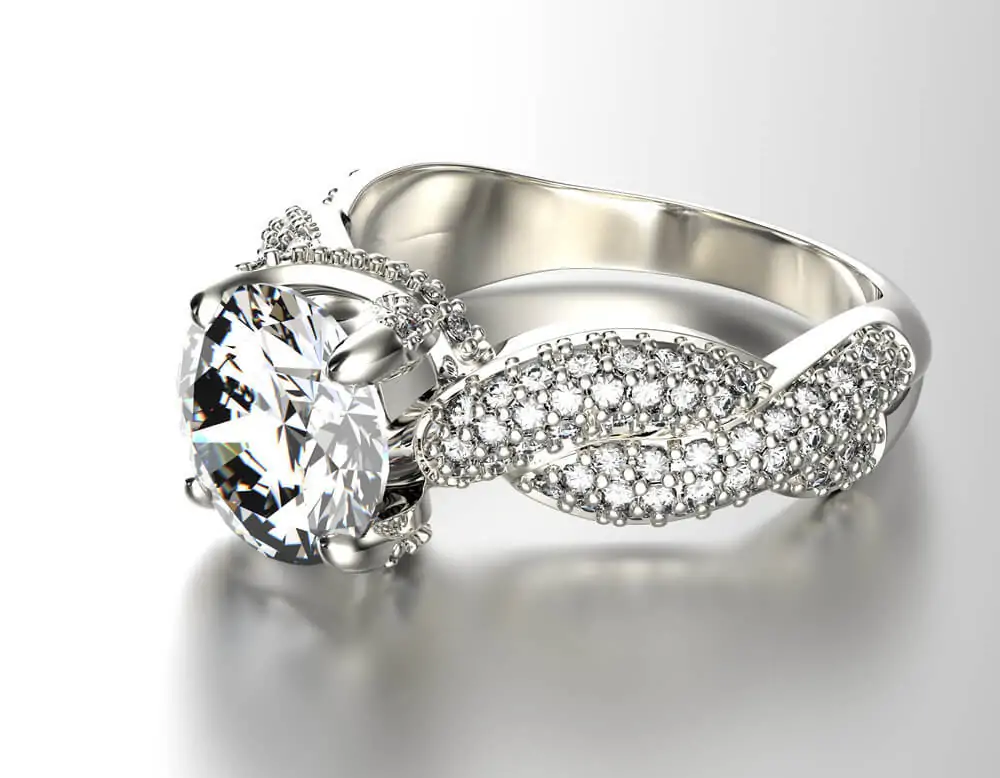
Table of Contents
As Jewelry Shopping Guide editors, we write about things that we love and we think you’ll like too. We often have affiliate partnerships, and may generate some revenue from these links at no cost to you.
Moissanites look almost identical to diamonds and make a great alternative if you want a diamond simulant for your engagement ring. They come with the look but not the cost, making them a budget-friendly option.
But:
Are moissanites worth the investment and do they hold any value at all? We attempt to answer this and any moissanite related question that you may have in this quick guide comparing diamonds and moissanites side by side.
What is a Moissanite?
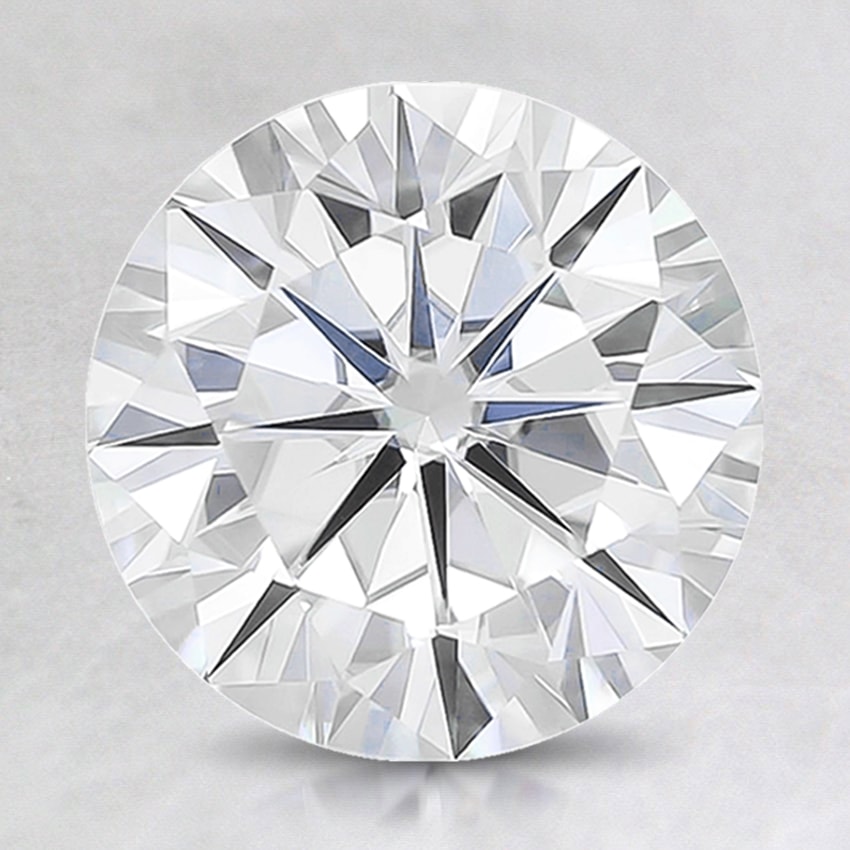
Moissanite is a diamond look-alike that is commonly used instead of diamonds for engagement rings. It was discovered in 1893 in Arizona by the Frenchmen Henri Moissan. Scientists determined that the mineral is silicon carbonate. Today all moissanite crystals are artificially grown in labs.
Moissanite stones appear to be colorless like diamonds, but can be found in varying tints, from near-colorless to tinted. Under certain light some moissanite exhibit a greenish tint. Because moissanites are lab-grown, there is a lot of control over what the final product will look like.
What is a Diamond?
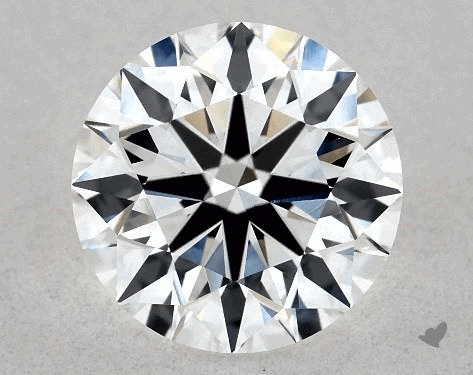
Diamonds are found abundantly in the earth’s crust. They are made of pressurised and heated carbon over millions of years. Diamonds come in a variety of colors with colorless diamonds being the most popular for engagement rings. Most diamonds are natural but there is a healthy market for synthetic diamonds as well.
Moissanite vs. Diamonds – Origin
One of the most mystical aspects of moissanite is its origin. Natural moissanite was brought to earth on a meteor thousands of years ago, making moissanite, quite literally, stardust. Because of this origin, moissanite is often called ‘space diamond’. Because natural moissanite is exceedingly rare, all moissanite today is lab-created.
In contrast, the origins of diamonds comes from the opposite direction – deep within the earth.
While some prefer the natural creation process of diamonds over years and years, others appreciate the scientific and cosmological origins of the space diamond.
Moissanite vs. Diamonds – Value
It goes without saying that diamonds are costly gemstones and although they are not rare, they are valuable. An excellent cut, flawless, D color 1 carat diamond like this one costs upwards of $14,000. On average, couples spend about $7000 for their diamond engagement rings, a very hefty sum.
This is where moissanite comes in as a great alternative to diamonds.
A moissanite engagement ring can cost up to 90% less than a diamond engagement ring. This colorless 1 carat moissanite costs a fraction of the price of a similar diamond.
However, there is one aspect to consider. Just because moissanite is lab-created and is not a diamond does not mean that it is necessarily cheap. Moissanites are created through an intricate and expensive process, with each stone taking several months to be created. It is a stone in its own right and while it is a much more inexpensive option to diamonds, it is still relatively expensive.
Moissanite vs. Diamonds – Appearance
Moissanites and diamonds look very similar in appearance, that telling them apart can be difficult for the average person. Even jewelers may sometimes require specialist tools to tell the two gemstones apart.
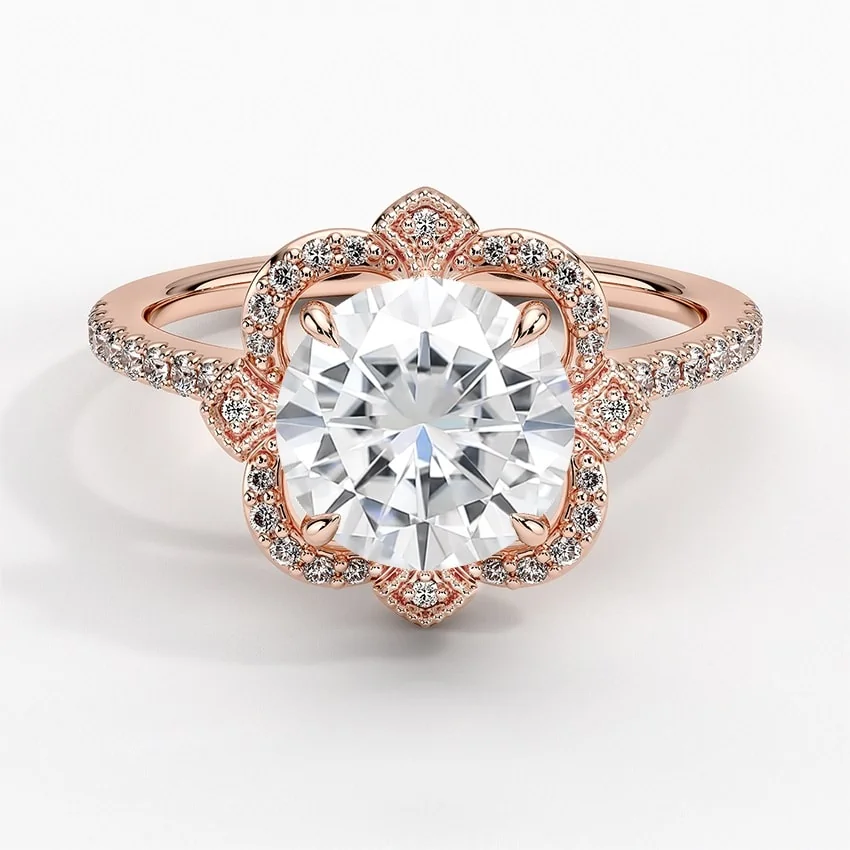
While diamonds are known for their brilliance, moissanites have a higher Refractive Index (RI) than diamonds, meaning that they are actually more brilliant. Brilliance in a gemstone is affected by the refractive index. While a diamond’s RI is 2.42, a moissanite’s is considerably higher at 2.65.
However, the type of brilliance between these two gemstones is quite distinct. A diamond’s sparkle is caused by the combination of brilliance, dispersion and scintillation, whereas a moissanite’s brilliance is fiery and colorful, due to their distinct faceting pattern. Diamonds sparkle with quiet depth while moissanites often have a rainbow effect.
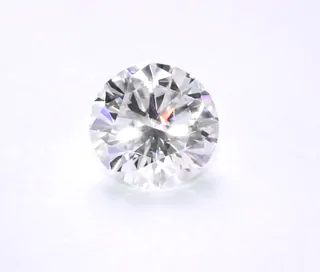
Under light, moissanites can exhibit flashes of color, as seen slightly in this particular stone.
This is one giveaway when differentiating between a diamond and a moissanite. It is important to note that some people love the rainbow effect of the moissanite while others may find it too much. The rainbow effect is especially noticeable in larger stones and when under direct sunlight. Consider this factor before you decide to purchase a moissanite. This is also why it’s important to check videos and images of the actual moissanite prior to purchase to see its light performance.
Moissanite vs. Diamonds – Durability
For engagement rings, the durability of the center stone is a critical factor. As this is a piece of jewelry that is generally intended to be worn on a daily basis, you would want it to be resistant to scratching and breaking.
Diamonds are the hardest natural substance known to man, with a Mohs rating of 10. A moissanite is not far behind, at 9.25, making it harder than all other gemstones except diamond.
Both stones are extremely scratch resistant and will generally take life’s hard knocks without damage or abrasion.

A diamond is the hardest gemstone there is, making it an exceptional choice for daily wear.
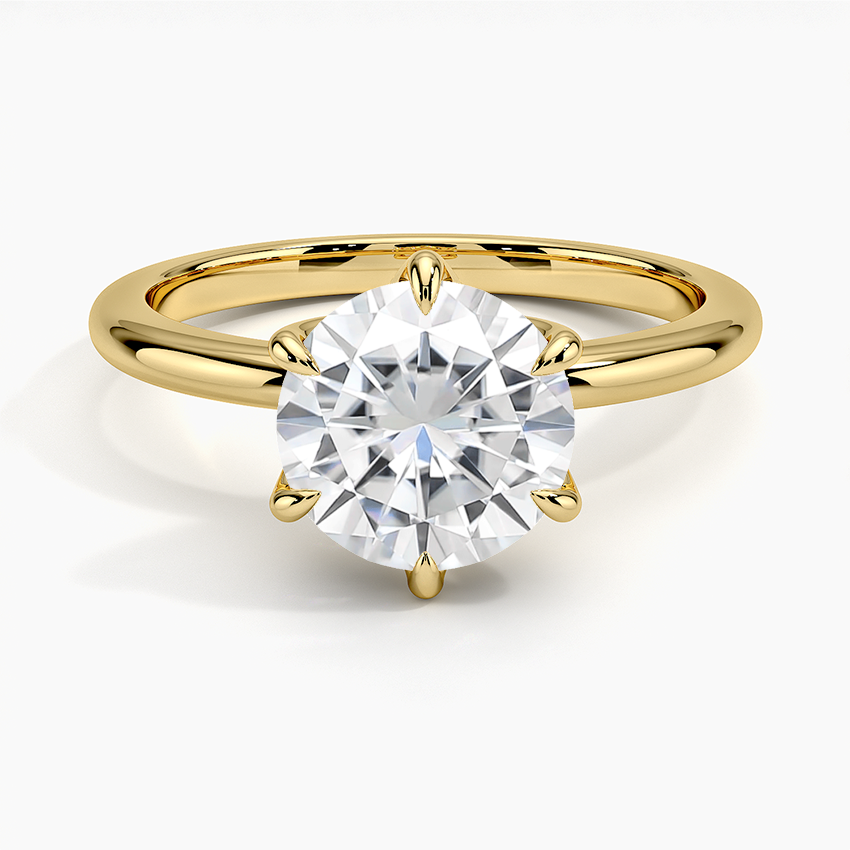
A moissanite engagement ring can withstand daily exposure, just like a diamond.
One benefit moissanite has over diamond is that it is more heat resistant. This means that even when subject to intense heat, the moissanite will retain its brilliance and form.
Moissanite vs. Diamonds – Ethical Concerns
There has been a lot of talk about blood diamonds and the environmental impacts of diamond mining.
The diamond mining industry is fraught with controversial issues of exploitation, low-wages, dangerous working conditions, funding wars, unfair labor practices and so on. In addition to this, mined diamonds cause huge environmental devastation due to mining methods, destroying eco-systems and impacting sustainability. While much effort is now being taken to combat these issues, there’s still a long way to go. Often tracing a diamond back to its original source can be very difficult.
Contrary to this, moissanites are eco-friendly and a sustainable choice, as they are produced in labs. You can easily trace them back to their source of origin.
Moissanite vs. Diamonds – 4Cs
While diamonds are graded by cut, color, clarity and carat, moissanites are graded by color only and are not measured by the standards of the 4Cs. For diamonds, cut is the most important factor as it brings out the stone’s brilliance.
Moissanites are generally flawless and while they may have different internal characteristics, these do not affect the clarity of the stone and are not visible to the naked eye. Diamonds, on the other hand, often contain some flaws. Even the best diamonds may have tiny flaws within them. This is one indication of a diamond’s authenticity.
In terms of color, there are three main grades of moissanite available on the market. These are colorless (D-F), near-colorless (G-I) and slightly tinted (J-K). The colorless range will be more expensive than the other two ranges. These are the same color grades for diamonds too. Needless to say, D-E-F color grade diamonds are the most sought after.
In terms of carat, most retailers tend to measure moissanite in millimetres unlike diamonds which are measured in carats. Due to their lower density, a moissanite weighs about 10% less than a diamond.
This means that while a 1 carat diamond and a 6.5mm moissanite would be equal in size (in mm of the diameter), the moissanite would weigh about .88 carats. This is just a difference to note as it does not impact the stone in any way except that your moissanite will be slightly less heavy than a diamond of equal size.
The final verdict…
Both diamonds and moissanite have their pros and cons. While moissanites are an affordable, durable and brilliant alternative to diamonds, they are also intriguing stones in their own right. However, a diamond will always have an edge when it comes to prestige and value. Thanks to clever marketing and societal perceptions, diamonds are a class above moissanite and always will be. Which you choose depends on a number of factors including your budget, your values and what you perceive is important in life.
Where to Buy Diamonds and Moissanite Online
When buying jewelry online, be it diamonds or moissanites, always ensure that you are purchasing from a trusted source. Always check the after sales policies, especially the returns policies.
For diamonds, we recommend Blue Nile or James Allen for their competitive prices, high quality images and HD videos that make it the next best thing to viewing the diamond in person prior to buying. James Allen has the edge in this department due to their breathtaking Diamond Display Technology. They also offer excellent customer service and assistance throughout the buying process. Check out our article comparing the top online diamond retailers.
Because moissanite does not come with a lab report, it’s important to purchase from a reputable company to avoid being ripped off. Ensure that there are videos and images of the actual stone to assess its light performance. For moissanite, Brilliant Earth stand out as the best in the industry with an established reputation for providing stunning moissanite gemstones and moissanite jewelry.
Here’s an infographic for quick recap comparing moissanites and diamonds.
